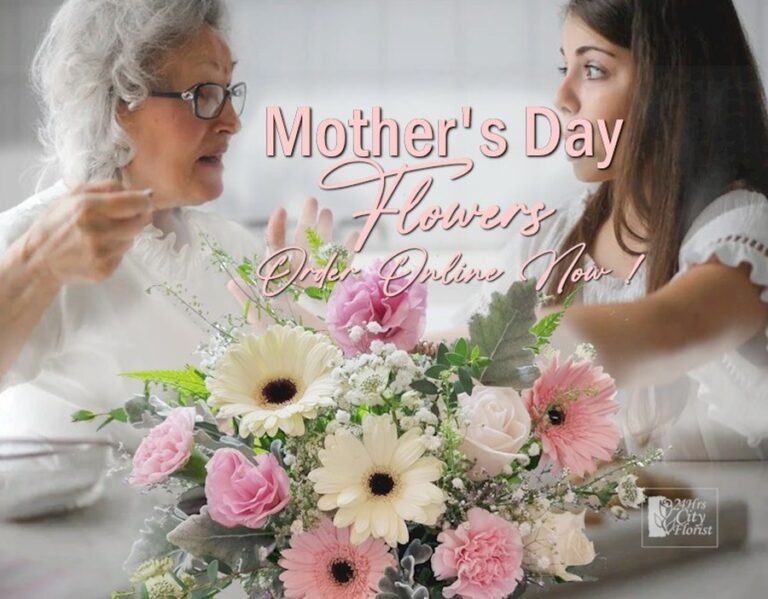Peony Flower
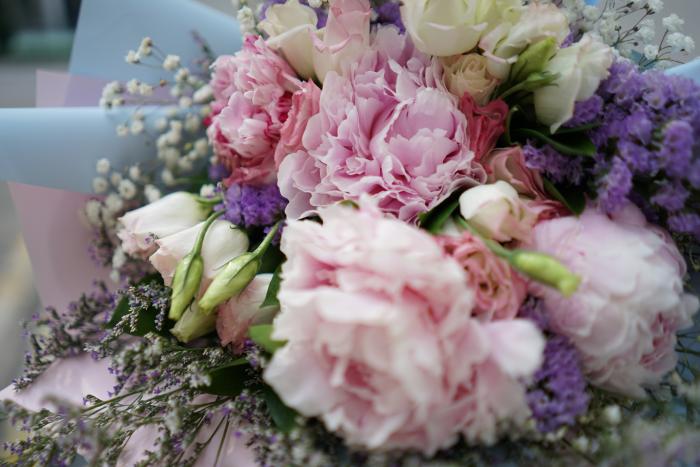
What are peonies?
As the ice thaws and the sun peeks out from the clouds, the peony flowers come out to play! Peonies, sometimes mistaken for garden roses, is a flowering plant native to both the East and the West – namely Asia, Europe, and the western parts of North America. There are over 30 species of peonies. Peonies are perennial flowers that only bloom at certain times of the year, namely in spring and summer. They are known for their large, lush, billowy, overlapping petals, and can come in a variety of colors – pink, red, cream, and the more uncommon yellow. The scent of the peony flower, which is regarded for its soft, feminine, fresh and sparkling qualities, is also a popular fragrance component.
Can you grow peonies in Singapore?
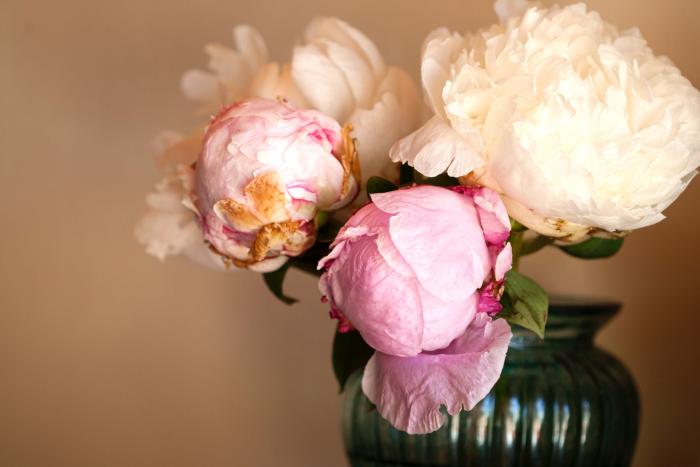
The short answer is no. Peonies flourish best in temperate climates, as opposed to our tropical one. They require long periods of dormancy each cycle; whereby the plant is not dead but does not bloom as it is in a resting state to conserve energy. In order for this to happen, very cold temperatures are required, to the point whereby the ground freezes. So unless the peony plant is placed in a very controlled environment with optimal growing conditions, it is unable to bloom in Singapore. Have no fear though, many florists on our sunny island still carry and deliver various types of peonies seasonally!
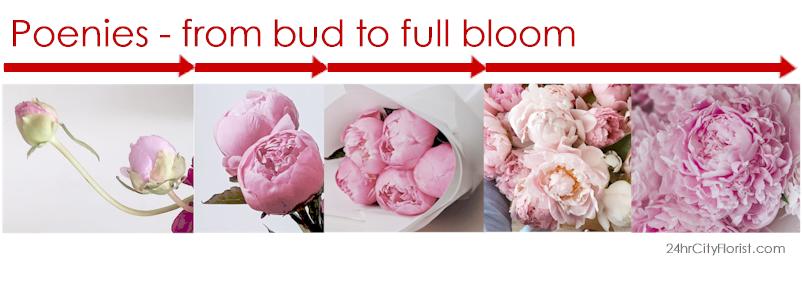
This elegant peony flower bouquet, consisting of dark pink and cream blooms, are available for order at 24hrCityFlorist. Flower delivery services available.
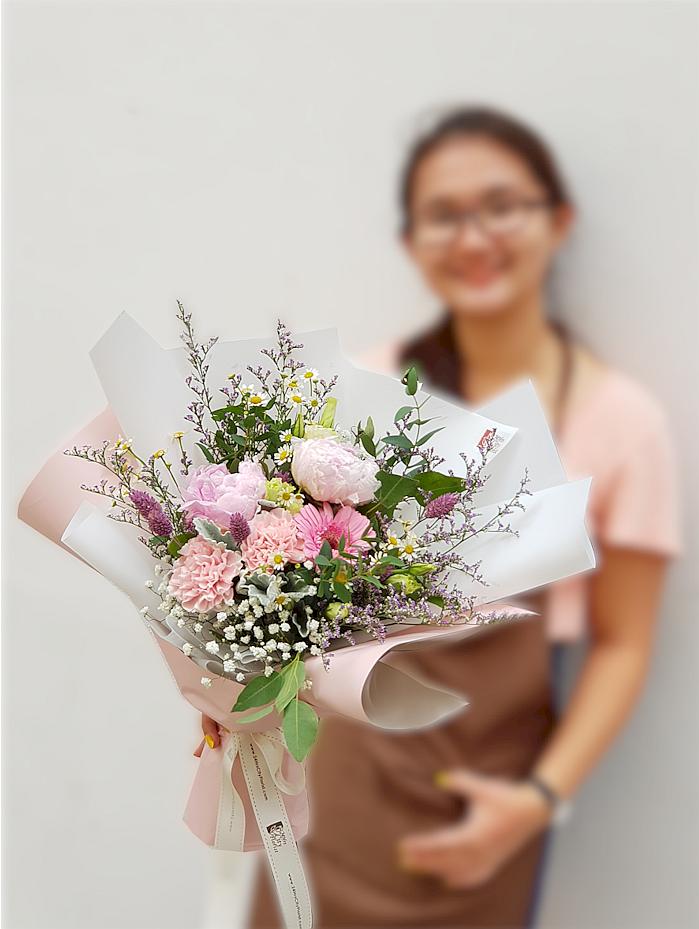
Types of Peonies
There are 3 main types of peonies: Herbaceous peonies, Itoh peonies, and Tree peonies.
Herbaceous peonies, also known as bush peonies, bloom in March and wilt in winter, where they usually fall to the ground. These peonies have green stems and are known to be sturdy, requiring little care. There is usually one bloom per stem.
Itoh peonies, as the name suggests, has Japanese roots as it was successfully cross-bred by a Japanese Horticulturalist named Toichi Itoh. As a hybrid between the Herbaceous peony and the tree peony, it has both of its characteristics. They are also durable flowers, and are popular in bouquets, being able to sustain through out long florist delivery durations.
Tree Peonies, as opposed to the herbaceous peony, have woody stems that stay above ground even when they defoliate during fall. They take longer to grow than the herbaceous peonies, but can grow taller and have bigger blooms.
Bloom Types
The peony flower has various bloom types, which refers to the shape of the head of the flower. The next time you visit a florist, you would be able to point out exactly what type of blooms you are looking for!
Single Bloom Peony
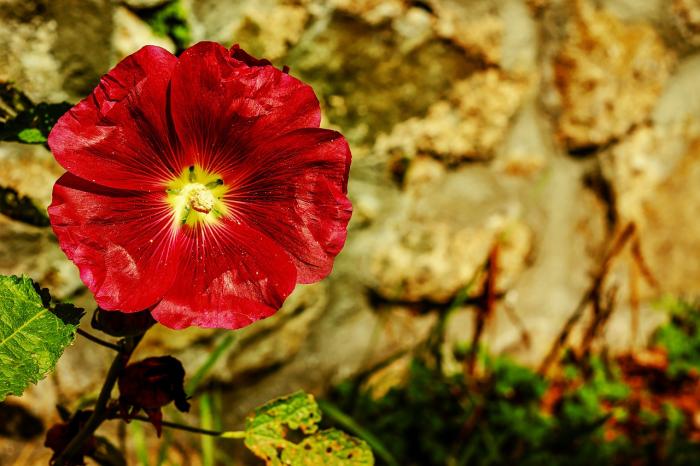
Single peonies have one or a few rows of petals surrounding the stamen.
Semi Double Bloom
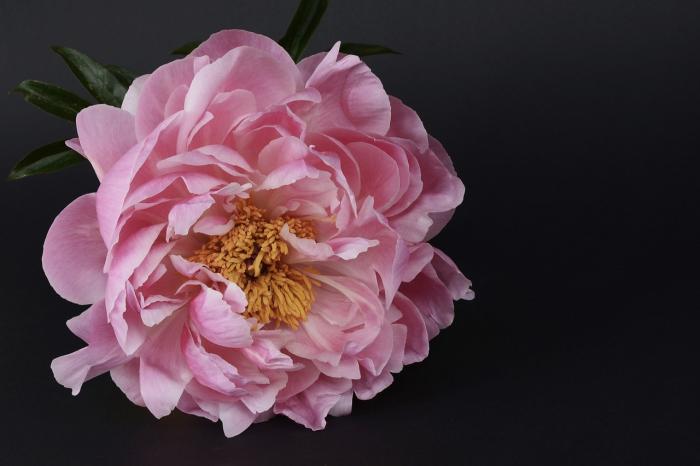
Semi-double peonies have a fuller look than the single peony as they have more rows of petals. The stigma and stamen are still present.
Full-Double Bloom
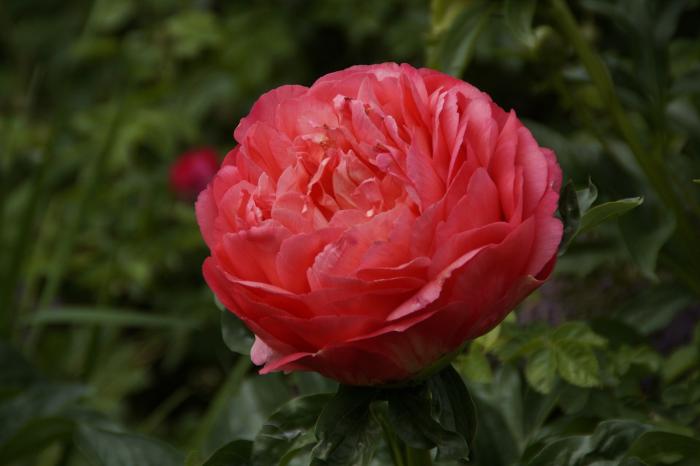
Full-double peonies also have multiple rows of petals. The crown of the flower is covered by petals, and the stamen and stigma cannot be seen.
Japanese Bloom
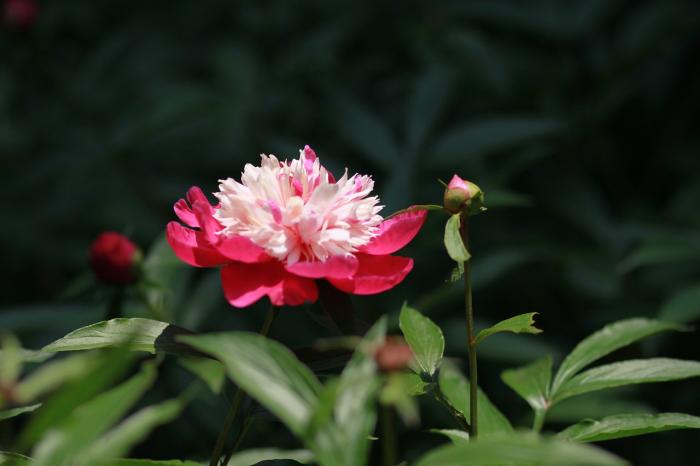
Japanese peonies have unique stamens, whereby they take on a petal-like resemblance. Japanese blooms are called so not because they originated from Japan, but because of their popularity in the country.
Bomb
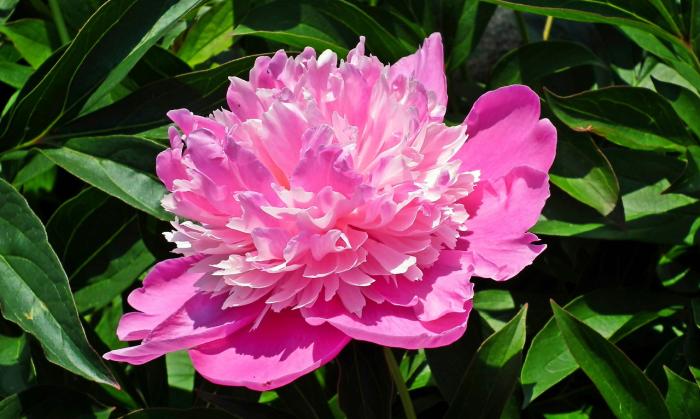
In the case of the bomb peony, its guard petals (petals surrounding the outer layer of the peony) are longer than the petals inside, which resembles a floral explosion of sorts. The stamen and stigma are enveloped between the long petals.
Peony blooms can be presented in a myriad of shapes and colours. Through years of research, the number of peony variations have increased with time and it is not easy to keep track of all of them!
Caring for a Peony Bouquet
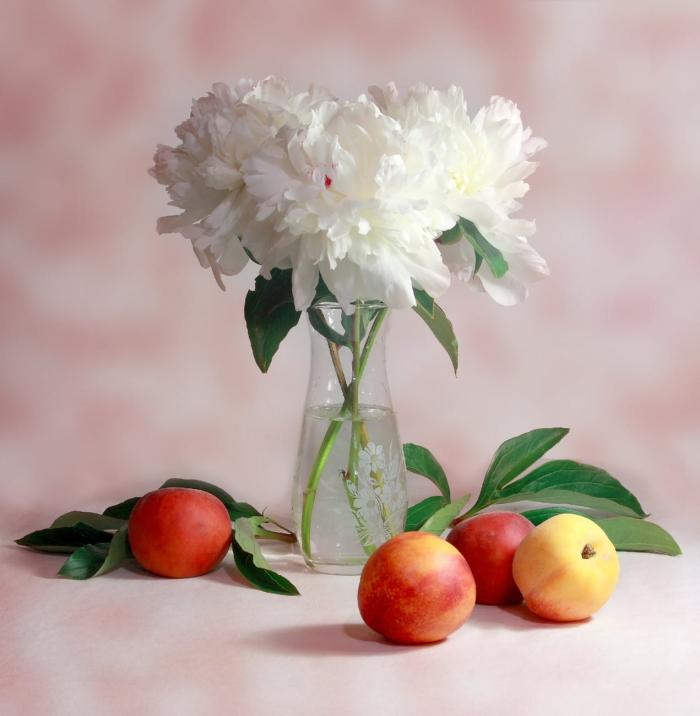
In order to prolong the life and appearance of cut flowers, there are various measures you can take that may only require 5 minutes of your time a day. Remove the flowers from the wrapping and diagonally cut off about 2cm of the stem from the bottom. Put them in a thoroughly washed vase. As peonies have large heads, you can place the stalks in a criss-cross manner to prevent the heads from touching each other.
Fill the vase with about a third of water, and remove any leaves touching the water. Change the water every day. You can also add flower food into the water, as per the flower food packet’s instructions. To further prolong the flowers’ life, store them in a cool and dark room away from direct sunlight, or add ice cubes into the water. Direct sunlight and warmth causes plants to wilt quickly as they are unable to absorb as much water from the roots as moisture is being taken away from the plant, in a process called transpiration. If your peony is not fully in bloom, you can use warm water instead to open up the flower.
The Peony’s Significance In Various Countries and Cultures
As peonies are lush, beautiful flowers, they have served to be an inspiration to various cultures and countries, inspiring the birth of various symbolisms across different regions. Compared to the rose, which is often seen as a classic symbol of passion and romance, the peony is often seen as a regal flower of understated elegance. In 2017 alone, China exported more than 2.7 million dollars of peonies into the United States, the European Union, Australia, Southeast Asia and the Middle East! It appears that the beauty of peony flowers is being appreciated globally.
As I was interested in what my peers’ thought of the peony flower, I conducted a little survey among them to find out what their impressions of the peony flower were.
When asked which cultures they thought the peony is synonymous with, most picked Chinese, Japanese, followed by various European countries. The peony is indeed most prominently found in the histories of these countries, as the flower is native to their temperate climates. Of course, thanks to the efficient transport systems we have today, the peony flower has also managed to make its way into the festivities of countries in which the peony is not native to, and has even appeared in Malay weddings!
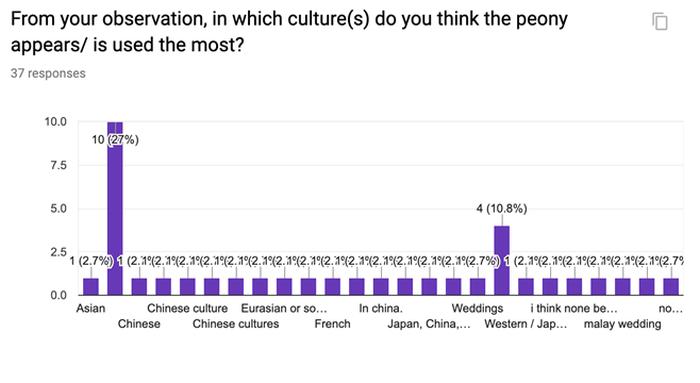
China
The peony has a long history in China, dating back to 551BC where peonies were used to flavor food as well as used as medicine. In the Tang dynasty, Peonies started to be taken in high regard as it was cultivated in the imperial gardens. Known as the ‘King Of Flowers’, the Peony represents prosperity, opulence, beauty, and honor. Its nobility and elegance had inspired countless paintings, poetry, and music. The peony has also inspired the Chinese idiom 國色天香, which roughly translates into “reigning beauty and heavenly fragrance”. This idiom was then later commonly used to describe feminine beauty. In the Qing dynasty, Dowager Cixi named the Peony the national flower. However, the current Chinese national flower remains undecided, as the plum blossom is also a strong contender.
Japan
Peonies were brought to Japan from China in 8CE. They were initially seen as an important medicinal plant but were slowly regarded as ornamental over as they were planted in temples and court gardens. Similar to China, peonies in japan represent good fortune, and a righteous, noble spirit. Japan has significant peony culture due to its influence from China. The presence of these flowers in royal gardens have also contributed to their popularity. The Itoh peony breed also originated from Japan.
Greece
In ancient times, many European countries believed that the peony held medicinal properties. The root, bark, seed and flowers of the peonies are widely used to treat illnesses. The people believed that peonies symbolized healing.
In Greek mythology, it is said that the Peony’s name originated from the Greek god Paeon. Paeon was the disciple of Asclepius, who was the god of medicine and healing. Paeon extracted a liquid from the root of peony flower to cure Pluto, who was the ruler of the Underworld. Jealous of his success, Asclepius threatened to kill Paeon, but Paeon was saved by Zeus by turning him into a peony.
Another Greek tale suggests that nymphs would hide their naked forms in peonies to protect themselves from prying eyes. This led to the peony’s association with bashfulness.
South East Asia
As Singapore is situated in Southeast Asia, I was curious to know whether the peony was present in our history. Since the peony flower is not native to Southeast Asia due to its tropical climate, it appears that the Chinese were the first importers of the peony motif into Southeast Asia. The use of peony motifs and patterns are prevalent in Peranakan culture, which refers to Chinese settlers who migrated to the Malayan archipelago between the 15th and 17th centuries. As settlers in the Malayan region, Peranakans have developed their own hybrid culture based off both Chinese and Malay influences. Peonies are a significant part of Peranakan culture – the motif could be found in furniture, embroidery, decorative pieces and clothing items such as batik, which represents the amalgamation of Malayan and Chinese influences.
Peonies for Every Occasion
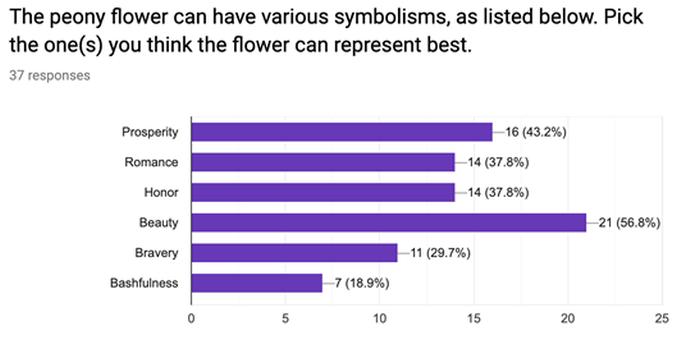
Curious as to what values my friends thought the peony would best represent based on its appearance, I included the question in my survey. When asked what kind of symbolisms the peony could best represent, majority suggested prosperity, romance, honor, and beauty. As such, they feel that gifting peonies can help them express these values!
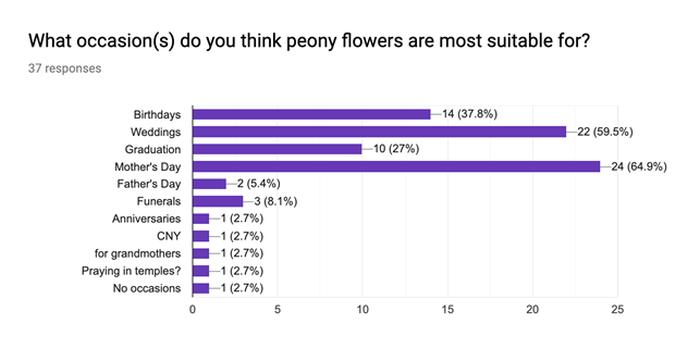
The peony’s beauty, elegance and symbolisms make it a popular choice for events like weddings, birthdays, and Mother’s Day. Other notable examples surveyees have included were Chinese New Year, anniversaries, temple visits, and even for grandmothers during Grandparents’ Day!
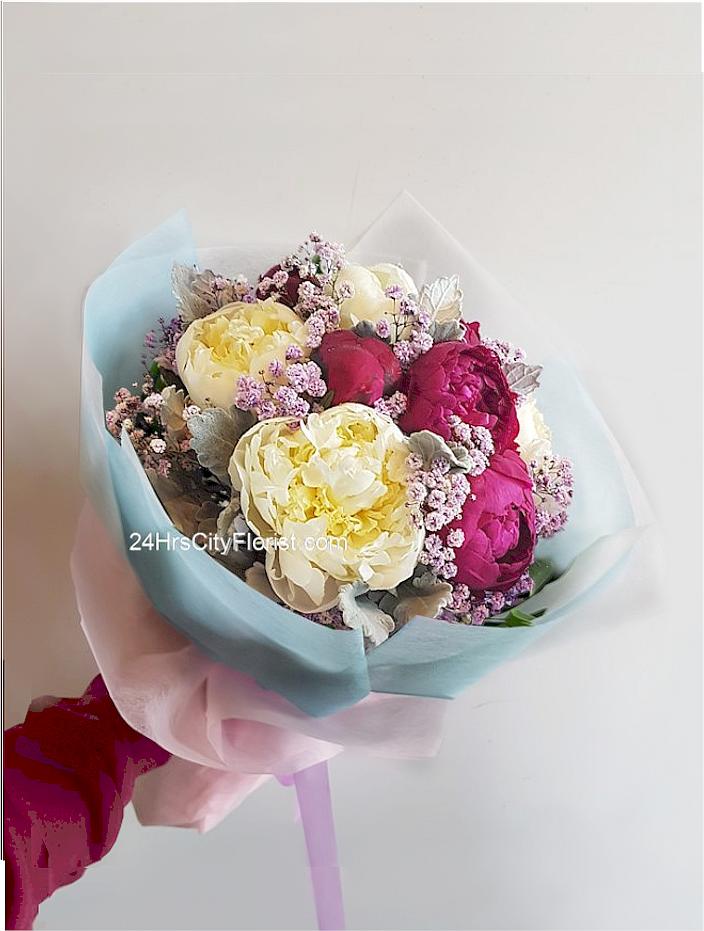
Weddings
Peonies are popular wedding flowers to add to a wedding bouquet or the venue’s decor as they symbolize a happy and prosperous marriage. These big, billowy, lush, and fragrant flowers would serve to add an elegant touch to the joyous affair. Do take note that peony flowers are available only seasonally, so contact your local florist early for availability!
Chinese New Year
Flowers are believed by the Chinese to bring good fortune and prosperity. Being considered the national flower of the Chinese, the auspicious peony is a popular choice of decor among many other oriental flowers, such as the pussy willow and peach blossom. Even though the Lunar New Year does not align with the peony’s natural blooming periods, many horticulturists have managed bloom tree peonies in time for festivities through the use of green houses. As such, peonies may be available at florists during this period despite not being in season! For the festive season, deep red peonies are considered to be more auspicious than their fairer counterparts.
Birthdays, Mother’s Day and Grandparent’s Day
Peonies are symbols of prosperity and beauty, exuding elegance and gracefulness. Peonies are perfect for the celebration of all the strong, beautiful women who brought us up throughout our lives. Be it birthdays, Mother’s Day, or Grandparent’s Day, the peony would definitely be a welcome addition to the celebrations.
In A Nutshell
Peonies are beautiful, elegant blooms that are highly regarded in many countries, and have a strong presence in various art mediums. They make great gifts for the special people in your life. Although peony is a flower that is only available seasonally, it is perhaps this ephemeral attribute that makes the peony even more special!
written by WeiQi,

